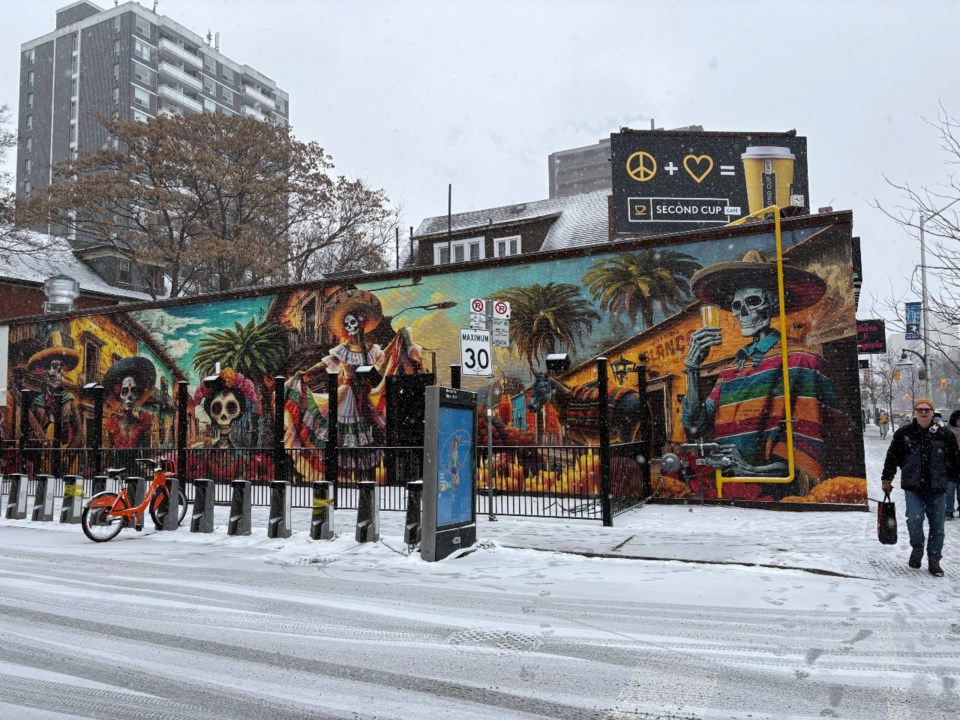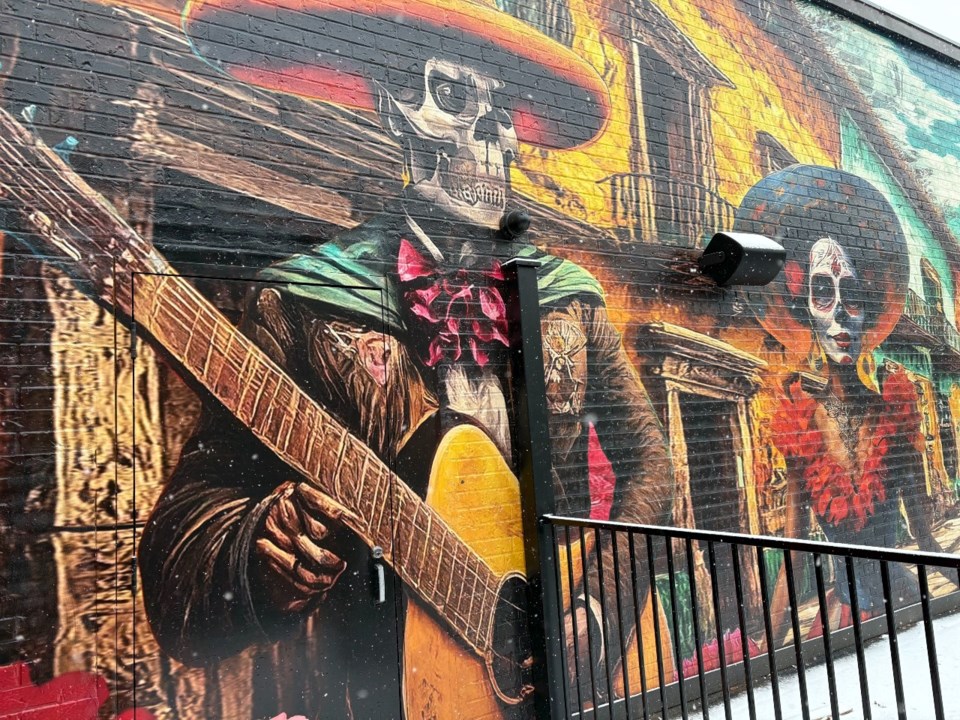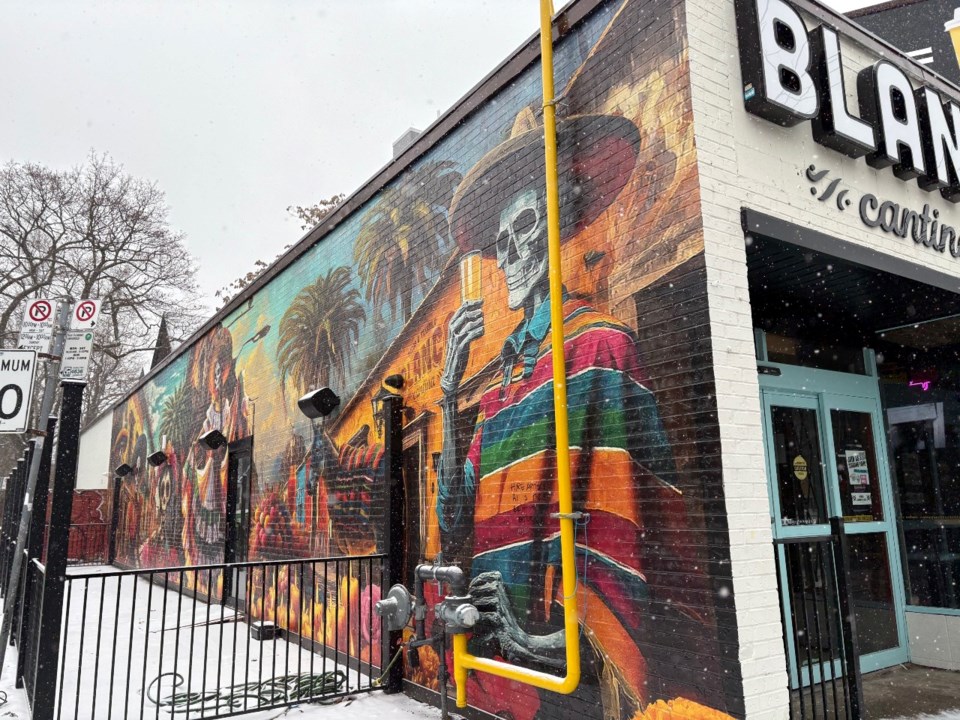A soon-to-be opened Mexican restaurant in Toronto’s Annex neighbourhood has brightened up a wall near Bloor Street — but not all are happy for the change.
Local muralist Sarah Blostein said she was initially excited to see the art. She told TorontoToday she appreciated the colours and the Day of the Dead-inspired design.
But she said those positive feelings quickly disappeared when she took a closer look and discovered evidence that the mural could have been developed using artificial intelligence (AI).
“AI — it’s not art. It is an algorithm that steals actual art from other artists,” she said. “It’s insidious.”
“It’s not only stealing the things you’ve taken time to make, but it’s stealing potential future income,” Blostein said of AI.
The new art is on the western wall of Blanco Cantina, a restaurant set to open at Bloor and Dalton streets in the Annex in mid-January.
Rather than being painted onto the wall, as most murals are, the new work is printed on a vinyl wrap that has been glued to the side of the building.
TorontoToday reached out to the business but did not receive a response by publication time.

Signs the mural could be AI generated
Blostein said there are several details that strongly suggest the new art was not developed by a graphic designer.
The first, is that the design seems to mash up several different artistic styles. The first mariachi skeleton in the image seems to be rendered in a post-impressionist style, mirroring Van Gogh, while the second is photorealistic, and the third is a bit cartoony, she said.
Human artists don’t tend to use multiple different styles in the same work, she added.
The lack of details in the background is also a sign it may be AI-generated, Blostein said.
“In the foreground, you’ve got doors and entrance ways. [But] the farther back it gets, the more it just turns into a jumble of nonsense,” she added.
John, another Annex resident, who asked TorontoToday to use only his first name, said the lack of guitar strings — and the poor rendering of the skeletons’ hands and teeth may be other indicators.
“No human artist would mess up drawing teeth that badly,” said John, who is an illustrator and graphic designer. “They can just be chicklets if they need to, but there’s still individual teeth.”
“These are just this blurry mess,” he said of the teeth.
AI sometimes struggles to render hands because they are a part of the human body that often appear small or are left out of the images on which computer algorithms are trained, according to Britannica.com.
Teeth are often also poorly rendered by AI because they too are small and highly variable.
“When scanning a photograph of a person with a missing tooth, for instance, an AI may conclude that all smiles have that same gap,” according to the article.

Concerns with AI
Pat, an Annex resident who walked by the mural on Monday, told TorontoToday she is appreciative of the new art — AI-generated or not.
“It’s lovely,” she said. “I like the colour. I like the vibrancy. It reminds me of Mexico…I’m looking forward to [the new restaurant] opening up.”
A few others who commented on a post about the art in a neighbourhood Facebook group, agreed.
“Instead of criticizing we should be thankful someone is taking on a business venture to bring to the neighbourhood,” said another neighbour. “A lot of start-up expenses [are] involved. More dining out options and jobs have been created. Maybe just say thank you.”
But while Blostein said she’s glad for the addition of colour to the neighbourhood, she said she believes AI-generated art causes real harm.
Completing a mural of that size would take an artist about two weeks and could garner a paycheque of about $10,000, she said.
If businesses turn to AI, they eliminate those potential commissions.

The wall has featured several murals
John agreed with Blostein, noting the new wall wrap covered up work that had been done by a human hand.
Photos from Google Images show the building’s wall featured three different works between September 2019 and August 2024.
Most recently, the wall featured bright graffiti artwork, in purple, red and blue.
In October 2020, the wall featured a design completed by local muralist Emily May Rose, whose work often features mischievous raccoons.
Having work commissioned by local artists makes the city feel like one big art gallery, said John.

In contrast, the new wall wrap on Dalton St. feels “cheap,” he said.
The local resident said the new wall “sticker” makes him wonder whether the food will be authentic if the mural isn’t.
“I’m not making accusations, but it makes me wonder,” he said. “I want to go to restaurants that feel authentic and feel like every element, from the food to the decor to the way they interact with the community is coming from a place of authenticity.”
